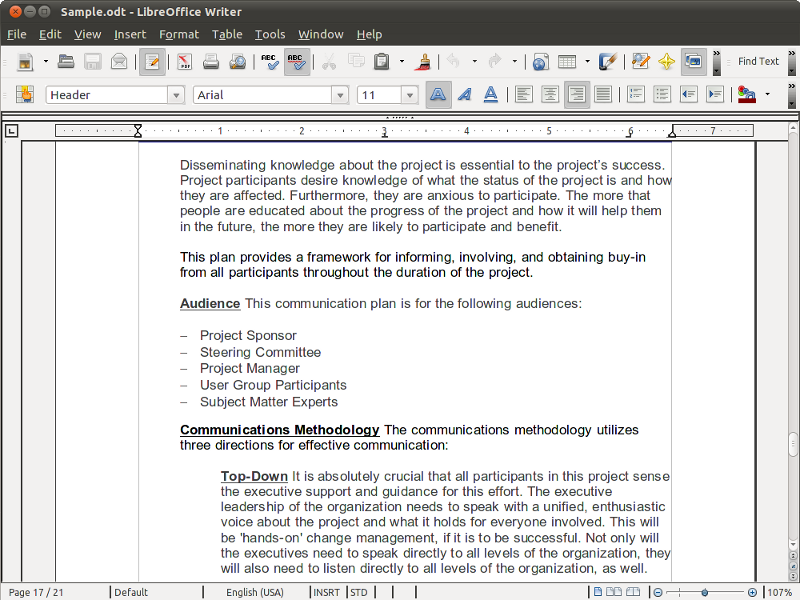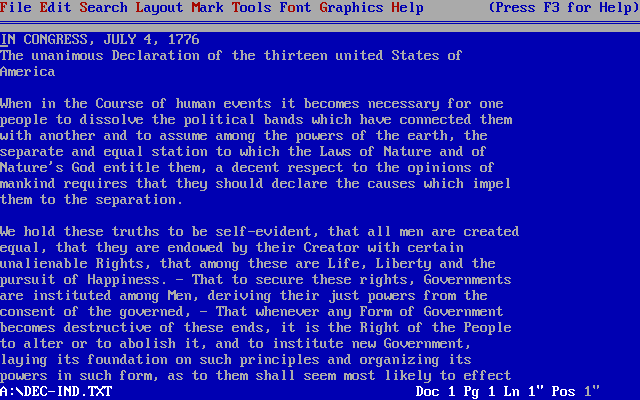|
Lotus 1-2-3
Lotus 1-2-3 is a discontinued spreadsheet program from Lotus Software (later part of IBM). It was the first killer application of the IBM PC, was hugely popular in the 1980s, and significantly contributed to the success of IBM PC-compatibles in the business market. The first spreadsheet, VisiCalc, had helped launch the Apple II as one of the earliest personal computers in business use. With IBM's entry into the market, VisiCalc was slow to respond, and when they did, they launched what was essentially a straight port of their existing system despite the greatly expanded hardware capabilities. Lotus's solution was marketed as a three-in-one integrated solution: it handled spreadsheet calculations, database functionality, and graphical charts, hence the name "1-2-3", though how much database capability the product actually had was debatable, given the sparse memory left over after launching 1-2-3. It quickly overtook VisiCalc, as well as Multiplan and SuperCalc, the two Visi ... [...More Info...] [...Related Items...] OR: [Wikipedia] [Google] [Baidu] |
Lotus Software
Lotus Software (called Lotus Development Corporation before its acquisition by IBM) was an American software company based in Massachusetts; it was sold to India's HCL Technologies in 2018. Lotus is most commonly known for the Lotus 1-2-3 spreadsheet application, the first feature-heavy, user-friendly, reliable, and WYSIWYG-enabled product to become widely available in the early days of the IBM PC, when there was no graphical user interface. Much later, in conjunction with Ray Ozzie's Iris Associates, Lotus also released a groupware and email system, Lotus Notes. IBM purchased the company in 1995 for US$3.5 billion, primarily to acquire Lotus Notes and to establish a presence in the increasingly important client–server computing segment, which was rapidly making host-based products such as IBM's OfficeVision obsolete. On December 6, 2018, IBM announced the sale of Lotus Software/Domino to HCL for $1.8 billion. History Lotus was founded in 1982 by partners Mitch Ka ... [...More Info...] [...Related Items...] OR: [Wikipedia] [Google] [Baidu] |
VisiCalc
VisiCalc ("visible calculator") is the first spreadsheet computer program for personal computers, originally released for the Apple II by VisiCorp on October 17, 1979. It is considered the killer application for the Apple II, turning the microcomputer from a hobby for computer enthusiasts into a serious business tool, and then prompting IBM to introduce the IBM PC two years later. More than 700,000 copies were sold in six years, and up to 1 million copies over its history. Initially developed for the Apple II computer using a 6502 assembler running on the Multics time-sharing system, VisiCalc was ported to numerous platforms, both 8-bit and some of the early 16-bit systems. To do this, the company developed porting platforms that produced bug compatible versions. The company took the same approach when the IBM PC was launched, producing a product that was essentially identical to the original 8-bit Apple II version. Sales were initially brisk, with about 300,000 copies sold. ... [...More Info...] [...Related Items...] OR: [Wikipedia] [Google] [Baidu] |
Graphical User Interface
A graphical user interface, or GUI, is a form of user interface that allows user (computing), users to human–computer interaction, interact with electronic devices through Graphics, graphical icon (computing), icons and visual indicators such as secondary notation. In many applications, GUIs are used instead of text-based user interface, text-based UIs, which are based on typed command labels or text navigation. GUIs were introduced in reaction to the perceived steep learning curve of command-line interfaces (CLIs), which require commands to be typed on a computer keyboard. The actions in a GUI are usually performed through direct manipulation interface, direct manipulation of the graphical elements. Beyond computers, GUIs are used in many handheld mobile devices such as MP3 players, portable media players, gaming devices, smartphones and smaller household, office and Distributed control system, industrial controls. The term ''GUI'' tends not to be applied to other lower-displa ... [...More Info...] [...Related Items...] OR: [Wikipedia] [Google] [Baidu] |
Consumer
A consumer is a person or a group who intends to order, or use purchased goods, products, or services primarily for personal, social, family, household and similar needs, who is not directly related to entrepreneurial or business activities. The term most commonly refers to a person who purchases goods and services for personal use. Rights "Consumers, by definition, include us all", said President John F. Kennedy, offering his definition to the United States Congress on March 15, 1962. This speech became the basis for the creation of World Consumer Rights Day, now celebrated on March 15. In his speech, John Fitzgerald Kennedy outlined the integral responsibility to consumers from their respective governments to help exercise consumers' rights, including: *The right to safety: To be protected against the marketing of goods that are hazardous to health or life. *The right to be informed: To be protected against fraudulent, deceitful, or grossly misleading information, adverti ... [...More Info...] [...Related Items...] OR: [Wikipedia] [Google] [Baidu] |
Academia
An academy (Attic Greek: Ἀκαδήμεια; Koine Greek Ἀκαδημία) is an institution of tertiary education. The name traces back to Plato's school of philosophy, founded approximately 386 BC at Akademia, a sanctuary of Athena, the goddess of wisdom and Skills, skill, north of Ancient Athens, Athens, Greece. The Royal Spanish Academy defines academy as scientific, literary or artistic society established with public authority and as a teaching establishment, public or private, of a professional, artistic, technical or simply practical nature. Etymology The word comes from the ''Academy'' in ancient Greece, which derives from the Athenian hero, ''Akademos''. Outside the city walls of Athens, the Gymnasium (ancient Greece), gymnasium was made famous by Plato as a center of learning. The sacred space, dedicated to the goddess of wisdom, Athena, had formerly been an olive Grove (nature), grove, hence the expression "the groves of Academe". In these gardens, the philos ... [...More Info...] [...Related Items...] OR: [Wikipedia] [Google] [Baidu] |
Lotus Manuscript
Lotus Manuscript is a discontinued MS-DOS-based word processor from Lotus DevelopmentAdvertisement:Don't hold back now. How do you really feel about working with columns? Lotus Manuscript Page 263, 13 Oct 1987, PC Mag, ''...our sophisticated table editor, script is not just another word processor....It's a complete document creation system, with more impressive features than 1-2-3...designed to work on most IBM“ PCs and compatibles...'' first released in 1986. The software was distributed on eight 5¼" diskettes and retailed for US$495. Features First released in 1986, Lotus Manuscript was one of the first MS-DOS word processors and being sop ...[...More Info...] [...Related Items...] OR: [Wikipedia] [Google] [Baidu] |
Word Processor
A word processor (WP) is a device or computer program that provides for input, editing, formatting, and output of text, often with some additional features. Early word processors were stand-alone devices dedicated to the function, but current word processors are word processor programs running on general purpose computers, including smartphones, tablets, laptops and desktop computers. The functions of a word processor program are typically between those of a simple text editor and a desktop publishing program; Many word processing programs have gained advanced features over time providing similar functionality to desktop publishing programs. Common word processor programs include LibreOffice Writer, Google Docs and Microsoft Word. Background Word processors developed from mechanical machines, later merging with computer technology. The history of word processing is the story of the gradual automation of the physical aspects of writing and editing, and then to the refinement ... [...More Info...] [...Related Items...] OR: [Wikipedia] [Google] [Baidu] |
WordPerfect
WordPerfect (WP) is a word processing application, now owned by Alludo, with a long history on multiple personal computer platforms. At the height of its popularity in the 1980s and early 1990s, it was the market leader of word processors, displacing the prior market leader WordStar. It was originally developed under contract at Brigham Young University for use on a Data General minicomputer in the late 1970s. The authors retained the rights to the program, forming the Utah-based Satellite Software International (SSI) in 1979 to sell it; the program first came to market under the name SSI*WP in March 1980. It then moved to the MS-DOS operating system in 1982, by which time the name WordPerfect was in use, and several greatly updated versions quickly followed. The application's feature list was considerably more advanced than its main competition WordStar. Satellite Software International changed its name to WordPerfect Corporation in 1985. WordPerfect gained praise for its "loo ... [...More Info...] [...Related Items...] OR: [Wikipedia] [Google] [Baidu] |
DBase
dBase (also stylized dBASE) was one of the first database management systems for microcomputers and the most successful in its day. The dBase system included the core database engine, a query system, a Form (programming), forms engine, and a programming language that tied all of these components together. Originally released as Vulcan for PTDOS in 1978, the CP/M port caught the attention of Ashton-Tate in 1980. They licensed it, re-released it as dBASE II, and later ported it to IBM PC computers running DOS. On the PC platform in particular, dBase became one of the best-selling software titles for a number of years. A major upgrade was released as dBase III and ported to a wider variety of platforms, including UNIX and OpenVMS, VMS. By the mid-1980s, Ashton-Tate was one of the "big three" software publishers in the early business-software market, along with Lotus Development and WordPerfect. Starting in the mid-1980s, several companies produced their own variations on the dBase ... [...More Info...] [...Related Items...] OR: [Wikipedia] [Google] [Baidu] |
State Of The Art
The state of the art (SOTA or SotA, sometimes cutting edge, leading edge, or bleeding edge) refers to the highest level of general development, as of a device, technique, or scientific field achieved at a particular time. However, in some contexts it can also refer to a level of development reached at any particular time as a result of the common methodologies employed at the time. The term has been used since 1910, and has become both a common term in advertising and marketing, and a legally significant phrase with respect to both patent law and tort liability. In advertising, the phrase is often used to convey that a product is made with the best or latest available technology, but it has been noted that "the term 'state of the art' requires little proof on the part of advertisers", as it is considered mere puffery. The use of the term in patent law "does not connote even superiority, let alone the superlative quality the ad writers would have us ascribe to the term". Orig ... [...More Info...] [...Related Items...] OR: [Wikipedia] [Google] [Baidu] |
SuperCalc
SuperCalc is a spreadsheet published by Sorcim in 1980. History VisiCalc was the first spreadsheet program, but at first was not available for the CP/M operating system. SuperCalc was created to serve that market. Alongside WordStar, it was one of the CP/M applications bundled with the Osborne 1 portable computer. It quickly became popular and was ported to MS-DOS in 1982. An improvement over VisiCalc (though using much the same command structure using the slash key), SuperCalc was one of the first spreadsheet programs capable of iteratively solving circular references (cells that depend on each other's results). It would be over 10 years after the introduction of SuperCalc before this feature was implemented in Microsoft Excel, although in Lotus 1-2-3, manual programming of iterative logic could also be used to solve this issue. According to the SuperCalc product manager, iterative calculations were added when Sorcim changed from binary-coded decimal to binary math. Si ... [...More Info...] [...Related Items...] OR: [Wikipedia] [Google] [Baidu] |




